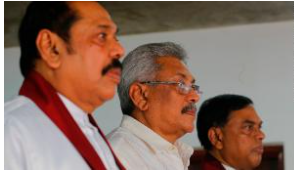For many years, it has been one of Sri Lanka’s grandest and most heavily guarded structures, serving as the President’s official residence and state office.
But that all changed on July 9, when protesters stormed in and took control, demanding President Gotabaya Rajapaksa’s resignation and turning the palace upside down.
“That was the home of the country’s most powerful man,” said Asanga Abeyagoonasekera, a Sri Lankan author and analyst. “It’d never been open to the public before.”
It’s now a novelty attraction, with no traces of exclusivity or prestige remaining. For the past five days, thousands of people have waited in line for hours to see Rajapaksa’s lavish lifestyle. Protesters swim and party in his private pool, and his perfectly manicured lawns have become picnic areas.
Rajapaksa left the crisis-torn country on Wednesday, taking a military plane to the Maldives and naming Prime Minister Ranil Wickremesinghe as Acting President.
He has since travelled to Singapore on a “private visit,” as confirmed by the authorities. On Friday, Rajapaksa’s resignation was accepted by Sri Lanka’s parliamentary speaker, putting an end to his nearly three-year term in office.
“Resignation was really the only option he had,” Abeyagoonasekera explained. People are tired, hungry, and angry. And they are demanding change and accountability because they are tired of seeing the same faces in power. “
‘We can’t afford to be picky.’
Although Rajapaksa is no longer in power, Sri Lanka remains mired in a crippling financial crisis, with experts predicting that things will worsen before improving.

Protests over daily power outages, rising fuel prices, and severe shortages of necessities such as food and medicine began in March and show no signs of abating.
“There is no political stability,” Abeyagoonasekera said. “We’ve seen three cabinets in the last two months, with a fourth on the way. To restore the country, immediate change is required.”
Despite a slew of government-implemented crisis-control measures, the situation for millions of people across the country remains dire. “We are still short on food, medicine, and fuel,” said Amita Arudpragasam, a political analyst based in Colombo. “Policies have also been ineffective and perplexing.”
According to analysts, the crisis began around 2019. However, many Sri Lankans saw the warning signs even before Gotabaya Rajapaksa’s brother Mahinda was re-elected President for a second term in 2010.
The Rajapksa era, according to Arudpragasam, was a “ticking time bomb.” “When the government should have been raising taxes, it instead gave huge tax breaks to the wealthy elite and corporations. Money that could have been reinvested in the population was used to repay debt obligations – none of which helped to address our economy’s many flaws.”
Gotabaya Rajapaksa took power in late 2019, having previously served in his brother’s administration as the unelected defence secretary.
Critics say he mismanaged the economy by spending a lot of money on the military and cutting taxes even though the rest of the world told him not to. This, they say, caused the government’s income to drop sharply.
“Rajapaksa ignored everyone’s advice and was supported by people who didn’t understand how an economy like ours worked,” Arudpragasam said. “(The government) refused to acknowledge the economy’s crisis until it was too late.”
She stated that immediate humanitarian assistance is required. “We are in a crisis and cannot afford to pick and choose.”
In 2020, Sri Lanka will be reclassified by the World Bank as a lower middle income country. This is because the currency has been falling apart and inflation rates are going up.
Prime Minister Wickremesinghe declared the country “bankrupt” earlier this month. “Our economy has completely collapsed,” he said.
(Curtesy CNN)